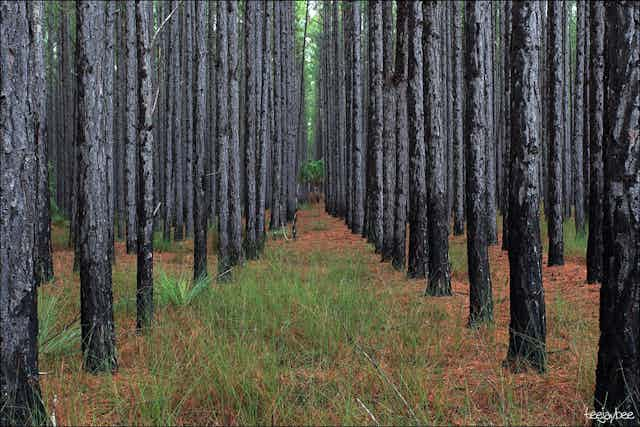Land-use planners and policy-makers often face claims and counter claims regarding the impacts of land-use change. For example, some residents claim wind turbines have crippling health impacts, while others see only a community asset and environmental gain. Some people suggest plantations decimate rural communities, while others see them as harmless and “just another crop”. How do we go about identifying the true impacts in these situations?
Our recently published study sought to untangle social change and impact in the context of complex land use shifts occurring in southwest Victoria and southeast South Australia. We focused on increases in cropping, dairying, grazing and plantations that occurred between 1991 and 2006, and examined the impact of these changes on rural population and employment. Where many changes occur at once in a region, sorting out the impacts of any one land-use change is not a simple matter.
We used independent data from a range of sources to understand what kinds of social changes were associated with increases in these land uses. We explored whether changes resulted in fewer people living in an area, or an ageing population, or changes in the percentage of the adult population in full-time employment.
We used interviews and surveys to understand how people living in the region viewed and experienced these changes. For example, we asked whether they believed increased plantations or cropping had a negative impact on population, and what any changes meant for them and their neighbours.
A comparison of independently observed social changes with impacts reported by residents revealed some surprising patterns. Increased cropping was the largest and most widespread change in land use across this region, yet very few residents were aware of this change.
Where cropping had increased, analysis of independent data showed it was almost always linked to negative social changes including an ageing population and fewer jobs available. Despite this, the majority of residents did not report experiencing negative impacts of increased cropping.
This contrasted sharply with patterns related to increased plantations. Plantation forestry in rural areas has received a great deal of media attention over the past two decades and the majority of residents were well aware of increases in this land use.
Social changes associated with increased plantations depend somewhat on the previous land use. Where the land was previously used for dairying, analysis of independent data suggested that a shift to plantations was linked to decreased population and employment. However, the more common shift from grazing to plantation was not always linked to population loss or decreased employment.
In some districts outcomes were relatively positive, in some negative, and in others there was little change at all. Despite this, the most common perception was that plantations have negative social impacts, decreasing the number of residents and the jobs available in these communities.
The conflict between actual and perceived changes makes more sense when viewed in the light of another finding. Independent data revealed that increased plantations were consistently linked with higher levels of population turnover. In other words, where plantations increased, it was more likely that former residents would move out of district and new residents move in. This pattern of change fits with a common practice in which whole farms were sold and redeveloped by plantation companies, with farm houses leased or sold to new owners.
When people described the impact of population-loss attributed to plantations, this undoubtedly reflected very real loss of longstanding friends, family and neighbours. Where new residents moved into the area, they could not simply replace the vital social networks within this community.
The impacts of these population changes are real and important. Land-use planners and policy-makers have a responsibility to consider how land-use change can be planned to minimise negative effects for rural communities.
This work reveals some of the complexities of both understanding and addressing impacts of rural land-use change. It suggests that people are not always aware of land-use changes. It also shows that perceived social change and impact are not always consistent with independently available evidence regarding that change.
Where a land use is less visible, we may be unaware of quite significant social changes. On the other hand, we may sometimes incorrectly attribute impacts to more visible land-use changes.
The research suggests that what we might think of as the “real” impacts of land-use change – the points at which independent evidence and experience agree – are not necessarily those we most commonly hear in public forums or media reports.
If land-use planners are to adequately address public concern about land-use change, they must understand both the change and the experienced impact of that change, and dig below the surface to understand the nature of that experience.

